Waterproofing Render – What You Need To Know
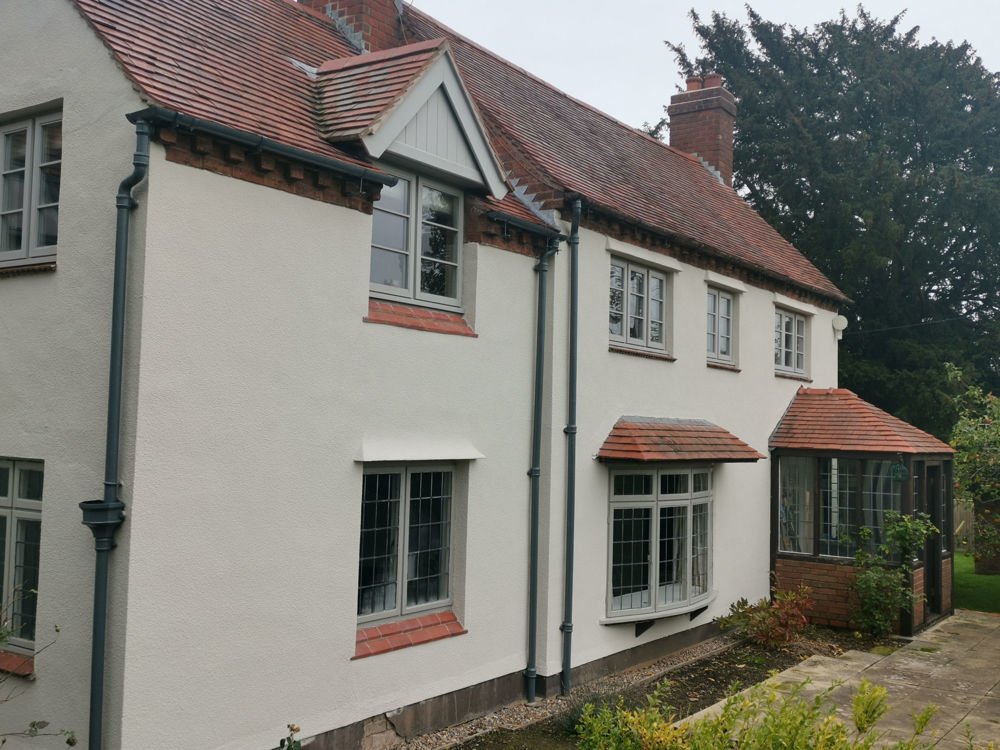
Like all exterior surfaces, ensuring render is waterproof is crucial for keeping it looking attractive and for keeping your home dry. We are often asked about whether render is waterproof & if not, how do you go about waterproofing render? That is why we have put together this handy guide that contains everything you need to know in one place before you decide what is best for you.
Is Render Waterproof?
When it comes to exterior walled surfaces, whether it be brick, stone or render, there is a common misconception regarding their ability to remain waterproof. Building materials are generally porous, meaning that they can uptake moisture. The more porous a surface, the more water that can travel through the pores of the material and be held there. If a surface is highly porous, it will not be waterproof as moisture will be able to travel through these pores consistently, keeping it saturated with water.
Renders come in a range of forms, with the weather resistance of the render varying depending on its formulation. Some of the most common forms of render include:
1. STANDARD RENDER
Standard render is the most common form of render that you will find it the UK, most often made up of a sand & cement mix. Standard render is a basic exterior render that has generally low resistance to water absorption, low breathability & low flexibility. Having said this, it is cost-effective and simple, meaning it has been a popular form of exterior wall protection over the years.
2. ACRYLIC RENDER
render is a form of render with an acrylic resin added to the mix that provides it with more water-resistance and flexibility than a standard render. The side effects of this added acrylic is that it can reduce the breathability of the render and also is less environmentally friendly.
3. SILICONE RENDER
Silicone render, as the name would suggest, is a render that has silicone added to its mix in order to provide it with a highly water-resistant finish that also remains breathable. This is in contrast to less advanced renders that have low breathability. This low breathability causes moisture to become trapped underneath the render as it cannot naturally escape in the form of water vapour. Eventually, this can cause cracks to appear on the render as the moisture attempts to escape. This combination of water repellence and high breathability provides silicone renders with superb durability. The highly advanced formulation and labour intensive nature of silicone renders does mean they come at a premium price, which is not often feasible for many. Some silicone renders can also be susceptible to discolouration, meaning although they are protecting the property, they can cause an eye-sore over time if not regularly cleaned.
4. LIME RENDER
Lime render is a more traditional form of render that is made from lime and sand that forms a mortar. Lime adds flexibility, which can help provide the render with protection against cracking, as well as adding a more attractive natural quality to the render. Used mostly found on traditional buildings, it is an eco-friendly option when it comes to render, although it can be more expensive and difficult to apply.
5. PEBBLEDASH
A popular form of render in the 1970’s, pebbledash is a form of render that has stones & rocks added to the composition of the render to provide a textured finish on exterior walls. While offering more resistance to weathering than other forms of render, unfortunately when these small rocks fall out, it can expose the render beneath. This subsequently means the render is left with little resistance to water absorption that then leads to issues relating to penetrating damp, that require other measures to be taken in order to keep the fabric of the building dry. While now often regarding as dated, pebbledash is a form of render that is often found in coastal and remote areas thanks to its durability.
In summary, the main factors when it comes to renders are their weather protection, breathability & flexibility, which all in turn contribute to the overall durability and lifespan of the render. The more waterproof, breathable & flexible the render, the longer it will be able to perform when weathered. Silicone render, thanks to its water repellent properties, is the render only render that can be considered completely waterproof. While other renders have weather resistance, they will allow some level of moisture to be absorbed over a period of time.

Why Should Render Be Waterproof?
As with any exterior walled surface, ensuring render is waterproof is crucial if you want to mitigate the numerous problems that are caused by moisture. To put simply, moisture is the single biggest cause of building material deterioration, especially in the UK where our properties are exposed to large amounts of rain almost all year round. Aside from the decay that is caused when building materials are left exposed to large amounts of moisture, water ingress can be extremely damaging to exterior walls. When water enters a wall, it can undergo a freeze-thaw cycle as the water freezes in colder months. When the water freezes from a liquid to a solid it expands. This expansion causes movement within the render, which in turn can cause cracks to open up. These cracks allow even more water to enter the render, which causes larger cracks and creates a continuous cycle of damage. This problem is made worse when low breathability renders are used, as they help to trap this moisture within the rendered walls, preventing it from escaping.
Penetrating damp is another key problem that is caused by water absorbing into render. During times of significant wind-driven rain, moisture that absorbs into the render can create damp problems as this moisture travels through the building envelope. In the case of solid wall properties, there is no cavity wall to block the moisture from travelling from the external wall into the internal wall of a property. This means that when the moisture enters through the render, it will continue to soak through into the interior of the house, causing black mould to form. While particularly a problem for solid walls, properties with a cavity wall are not immune to the problem. When a cavity wall is filled with insulation, the space necessary for water to freely escape the building can be removed. This means that a bridge can be formed between to external and internal wall, allowing moisture to travel through into the interior of the property. In cases where cavity wall insulation is not present, if the cavity is not completely clear this will also allow moisture to soak into the interior wall. Preventing this moisture from absorbing into the render is the only way to reduce the risk of penetrating damp from impacting a property.
Something many homeowners are not aware of is that water ingress is a key driver of heat loss in a property. To put simply, wet walls transfer heat quicker than dry ones. 5% damp content can lower the insulating properties of a material by 50%. Plus with 35% of a properties heat being lost from the walls alone, by having exterior walls that are saturated with moisture, you are at risk of losing significant amounts of heat from your home. This heat loss will result in the energy efficiency of a property being impacted, making it more difficult to bring the building up to temperature and keep it at that temperature.
Finally, water absorption on exterior walls does not just have an impact on the performance of the wall. Consistent exposure to high-moisture levels will have a significant impact on the appearance of the property. Damp patches, discolouration and the growth of lichens can all lead to rendered walls looking dirty & tired after a matter of years, especially with white render. Waterproofing the surface can prevent discolouration and discourage lichens from growing on the render, as they require high levels of moisture to survive.
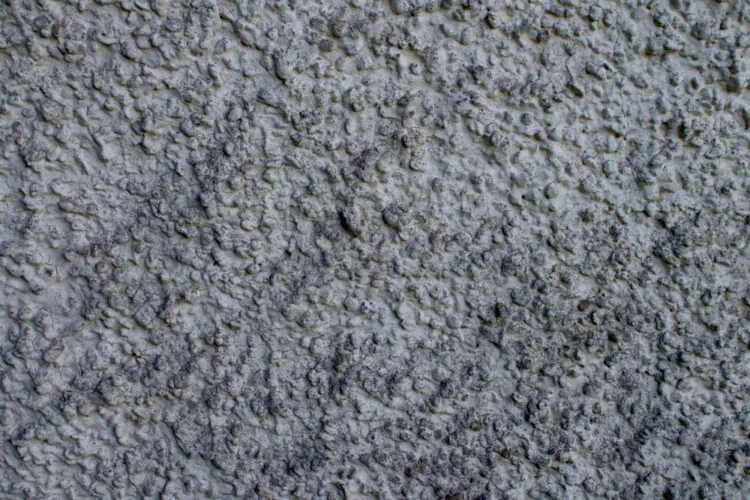
The Signs Of Water Penetration
There are a number of things that you can look out for in order to establish whether your render is suffering from water penetrating into the substrate. These include:
- Darkened patches of render at any level of the property
- Damp & crumbling interior walls. When the damp patches are rising up from the ground, this is a sign of rising damp. When the patches occur above the bottom brick level of the wall, this is penetrating damp
- Cold, hard to heat rooms
- Signs of black mould
- Hairline cracks on the render that increase over time
Any of these signs can indicate that moisture is finding its way into the render of a property, either through a defect like a crack or simply by soaking into the pores of the render. If the source of the moisture is not resolved, the problems will only worsen over time. That is why it is crucial to protect to prevent water penetration as soon as possible.
How To Waterproof Render
As we have already mentioned, advanced silicone renders already have waterproof protection. This is an isolated case however, with most forms of render allowing some level of moisture into the substrate.
The first step when ensuring render is waterproof is to investigate for any defects in the render. Check for any cracks, big or small on the surface of the wall. Even small hairline cracks will begin to increase in size as moisture undergoes a freeze-thaw cycle, as we have previously mentioned. It is crucial that you repair these cracks using an exterior filler in order to prevent further moisture from entering.
When any repairs are made to the render, it is also essential that you provide it with added weather protection in order to prevent the moisture from entering the material. A waterproof exterior coating must be applied to the render in order to create a water repellent surface that prevents water absorption.
There are a number of options when it comes to waterproof coatings, including masonry paint, masonry cream or masonry sealers. Any waterproof coating you use must be highly breathable. As with renders, if a coating is not breathable, it will trap moisture inside a wall, causing it to build-up. Over time, this causes even worse problems associated with moisture, such as damp, decay & eventually will cause the coating to be burst under the pressure of the moisture. The damage that can be caused by using a non-breathable coating can be huge, especially for older buildings that can be susceptible to deterioration.

Generally, when a waterproof product is referred to as a ‘sealer’ it has low breathability. These sealers do what the name would suggest and completely seal a surface, preventing water absorption but also preventing moisture from naturally breathing out of the coating. For this reason, if you want a long-term waterproofing solution, it is important to check whether a coating is a sealer or whether it has high breathability.
A masonry cream is a highly breathable clear waterproof coating that creates an invisible layer of protection on exterior walls. Masonry cream is applied to a gel to the exterior wall and over the course of a couple of hours absorbs into the material. When it absorbs into the material, it chemically bonds to it, meaning it waterproofs the render itself rather than creating a waterproof film on the surface of the wall. This highly advanced form of protection means masonry cream will offer complete waterproof protection to render without altering its appearance or breathability. As an impregnating system, masonry cream must be applied to bare surfaces that have not been previously painted, including bare render, brick & stone.
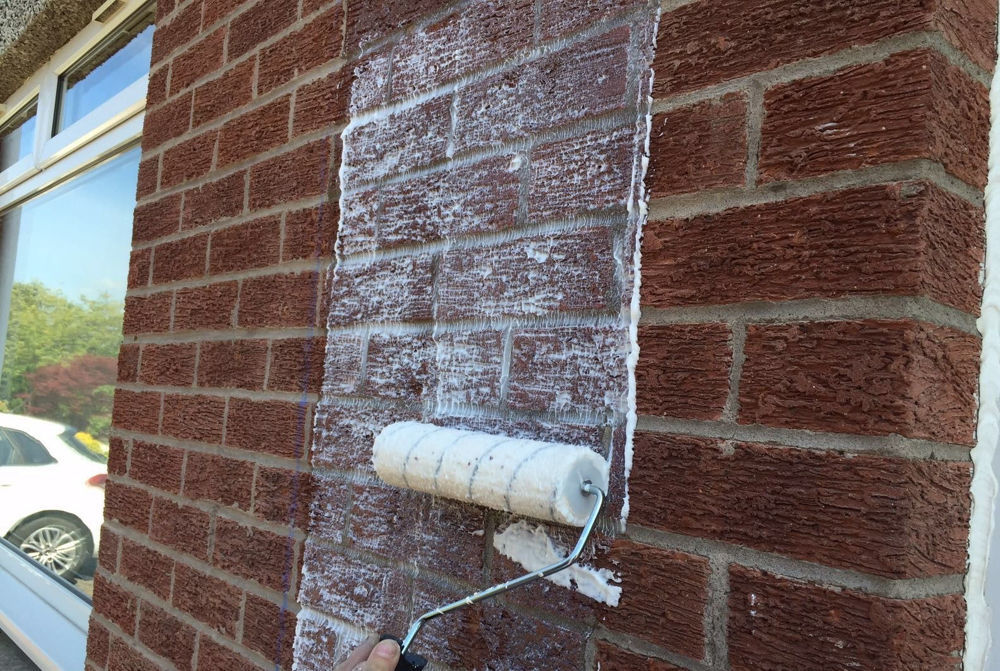
When it comes to a coloured waterproof coating for render, you must use a specialist masonry paint. The large majority of masonry paints available in the UK today are acrylic-based paints. These acrylic masonry paints offer varying levels of weather protection, although they all have low breathability due to the acrylic in their formulation. While often referred to as ‘weatherproof’ or ‘weather resistant’, acrylic masonry paint can absorb moisture in the same way as porous building materials like render, brick & stone, meaning they are not waterproof. When this moisture soaks through the coating and cannot escape due to the low breathability, the moisture will cause the paint to blister, flake or peel. This is why standard masonry paints generally come with a lifespan of between 3-15 years, as over a period of time moisture causes the paint to fail.
For a masonry paint to be waterproof, it must be water repellent. With silicone masonry paint, similar to silicone renders, the silicone provides the paint with water repellent properties that prevent any water from absorbing into the painted surface. The highly advanced technology in silicone masonry paint also provides high breathability and self-cleaning properties, as any dirt will wash away with rainfall.
The Emperor Paint waterproofing range contains highly advanced super hydrophobic nano-technology that reduces water absorption by 96%, by creating an ultra water repellent surface on exterior walls. It does this while remaining highly breathable, providing the products with unrivalled weather protection.
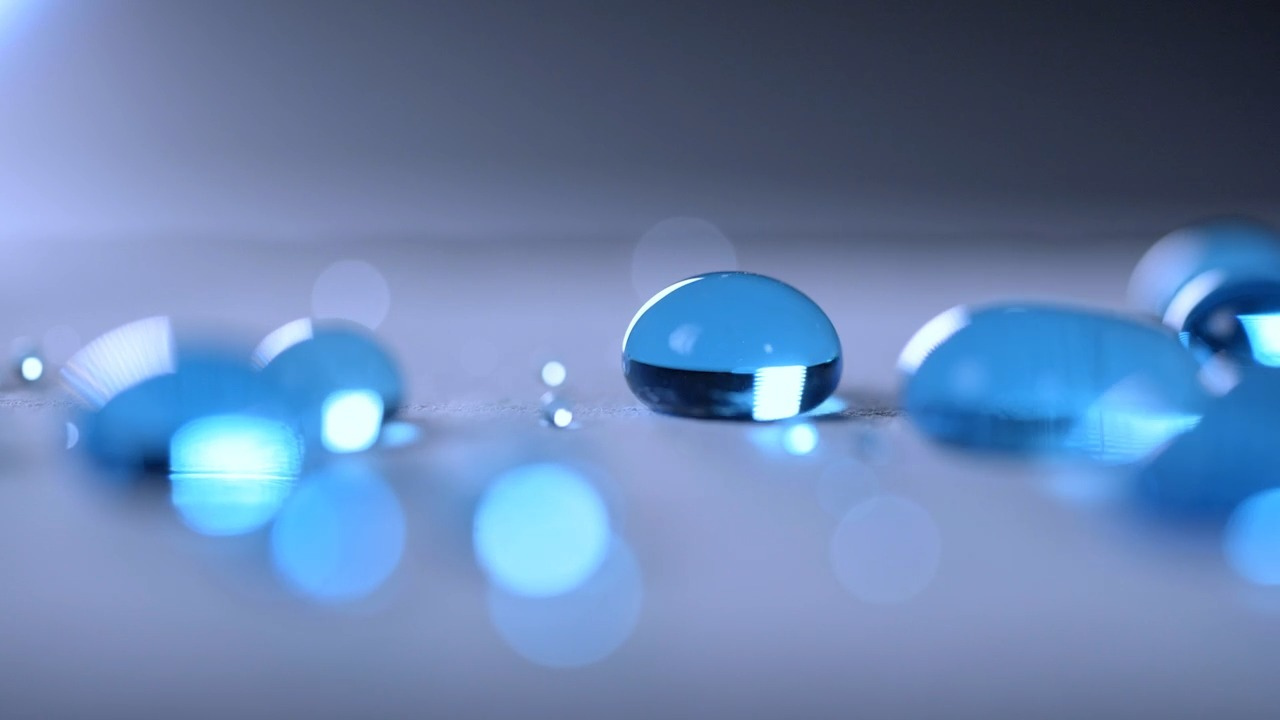
Emperor Masonry Paint & Emperor Masonry Creme were both tested by UKAS accredited laboratory Lucideon at their independent testing facility in order to establish their performance in a 25 year accelerated weathering test. After 25 years of heavy weathering, both products were found to have no change in appearance or performance. This demonstrated that they would perform for well in excess of a 25 year period, even in harsh weather conditions.
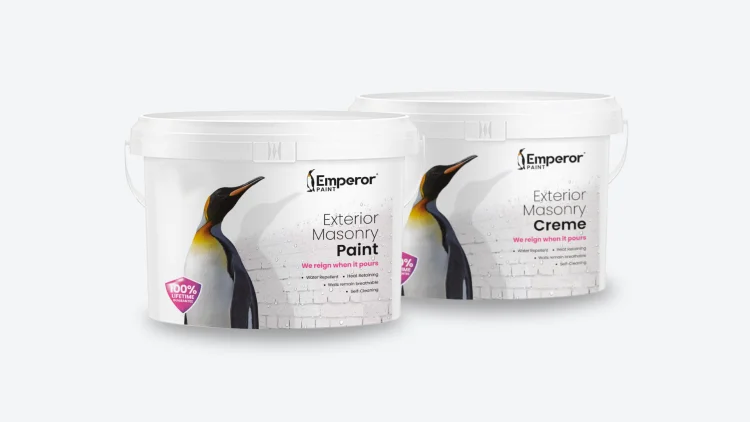
They were also found to have an SD value of 0.03 and 0.01 respectively. Any coating to be considered breathable must have an SD value of below 1, by British standards, making both Emperor Masonry Paint & Emperor Masonry Creme highly breathable. The final finding of the testing was that walls treated with the products were found to be 6°C warmer on average when compared to the wall left untreated. This demonstrated how by keeping the wall dry, Emperor Paint waterproofing technology improved the thermal performance of an exterior wall significantly.
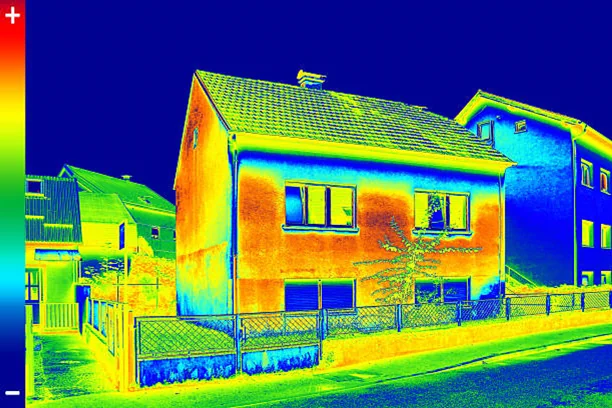
A sight that is common with rendered properties is discolouration, either from wet patches or from green growth. The super hydrophobic properties of Emperor Paint products create a self-cleaning surface that will not look tired and dirty after a matter of years. This is particularly useful for certain types of render that are notorious for discolouring from moisture.
Step By Step Guide
It is crucial that if you are looking to waterproof your render long-term, you must take the necessary steps in order to ensure you achieve high-quality results. Saving time by missing a step could mean you end up with a compromised finish and could result in you having to re-do the process again further down the line. Our step-by-step guide covers everything you need to know, from preparation to applying the waterproofing treatments. This guide includes steps for both applying masonry paint and masonry cream, as the two products require a slightly different application process.
YOU WILL NEED:
- Masonry paint or masonry cream
- Masonry cleaner
- Primer (if required)
- Long-pile roller
- Paint brush
- Paint scuttle
- Exterior filler (if required)
- Sandpaper (if required)
- Filling knife (if required)
- Dust sheets
- Window film
- Masking tape
1. PREPARATION
For long-term results, putting time into the preparation of the surface is your best use of time. Any decorator will tell you, preparation is the single most important part of the decorating process, especially when it comes to exterior surfaces.
The first step before anything else is to fill any cracks or holes in the render to prevent water from finding its way underneath the surface. If you have a very small hairline crack, it is recommended to make the crack larger as this will make it easier to get the filler into the crack. Rake the crack out using a multi-tool to a size of 1-2cm. You can then remove any loose rubble from the crack to ensure that the filler once dried can fully adhere to the inside of the defect. Using a good exterior filler such as the Toupret Masonry Repair Filler, fill the crack by working the filler back and forth into crack using a filling knife. Leave the filler to dry and then sand this back using a 120-grit sandpaper to get a smooth finish. Need to disguise your repairs? Emperor Textured Basecoat can be used to create textured finishes that hide blemishes and creates a seamless textured finish.
If you are painting render that has been previously painted, check that this paint is still sound. If there is any peeling paint, remove this using a scraper. If you do not remove this paint, the new paint will not be able to adhere properly to the wall. You want to remove the paint until you get a firm edge, where no more paint is flaking off when you scrape it.
Once the surface is sound, it must be cleaned before you paint. This is a step that some people miss, however it is crucial as any fungal growth left on the wall can bloom, causing any paint to fail. Any dirt on the wall can also impact the ability for the paint to stick to the wall. The wall can be first cleaned down using a hose pipe to remove any dirt or debris from the surface, or simply with a brush if there is very little dirt on the surface. On any areas that show mould or green growth, apply a fungicidal masonry cleaner such as Emperor Masonry Cleaner using a brush, roller or a spray bottle. Allow the cleaner to dry for a minimum of 2 hours before you apply anything to the wall. If you are painting over the surface, you do not have to clean off the cleaning solution. If you are applying masonry cream, clean the solution off the wall as this will be visible on the surface due to the invisible nature of masonry cream.
You can then mask any surfaces that you want to protect, such as windows & doors. Apply masking tape along any the edges of the wall or exterior trim and put down dust sheets on the floor to reduce the risk of paint splatter.
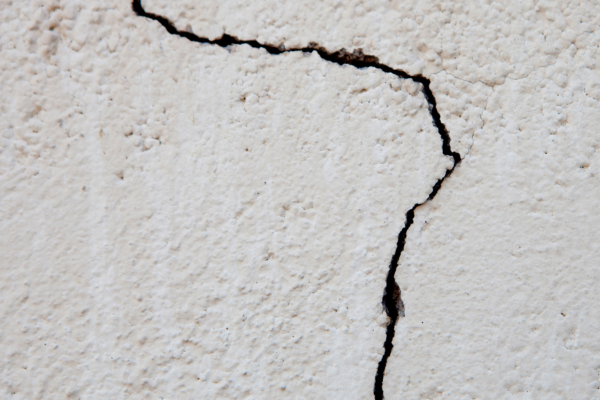
2. PRIMING
Applying a primer is only required if you are painting a bare surface using masonry paint. If it has previously been painted, you do not apply primer. Similarly, if you are applying masonry cream, you do not apply a primer.
A masonry primer is a thin liquid that is designed to improve the adhesion of paint to bare brick, stone or render. If you do not use a primer, your first coat of paint would partially absorb into the render, leaving you with a blotchy, uneven coating of paint.
Apply Emperor Exterior Primer using either a roller or a paint brush, aiming for a coverage of between 5-8m2 per litre, depending on the porosity of the render. Once you have applied primer to the full area, leave it to dry completely for 3-5 hours before starting with the painting.
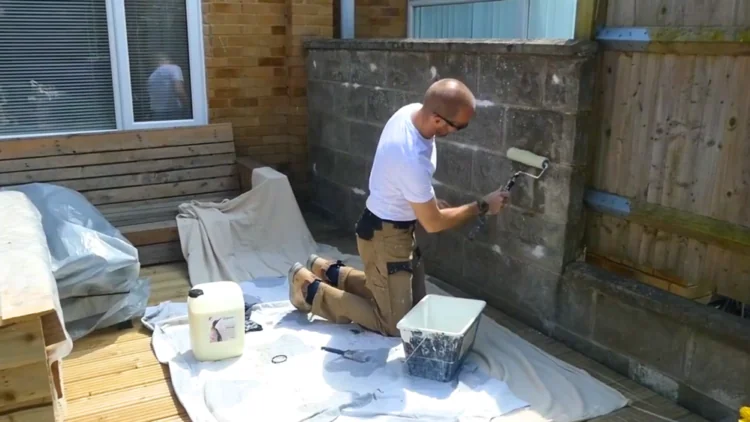
3. APPLICATION
Starting from the top of the wall, use a paint brush to cut in around the edges first as these can then be rolled over with a roller to create a perfectly smooth and even finish. This is the same whether you are using masonry cream or masonry paint. Once this is done, use your long-pile masonry roller to apply the coating to the rest of the surface. A long-pile roller has the longest fibres of any roller sleeve, which makes it best for rougher surfaces. You could also use a spray machine, however this should only be used by experienced spray professionals. Aim for a coverage of 5-6m2 per litre with Emperor Masonry Paint or 3-5m2 per litre with Emperor Masonry Creme.
Emperor Masonry Creme is a one-coat application system, so once applied to the render allow it to naturally absorb into the substrate. Emperor Masonry Paint is a two-coat application system, so you must wait for the first coat to dry before you apply your second coat. It will take approximately 8 hours for Emperor Masonry Paint to be recoatable, however it will be touch dry in a matter of hours, so do not worry if it suddenly rains a few hours after painting.

Apply the second coat of your paint, ensuring that you are achieving your desired finish. Leave your second coat to completely dry before you remove your masking tape. It will take a couple of weeks for the full ‘beading effect’ of the water repellent technology to be visible, although the paint will still be completely waterproof during that time. This is because it takes time for the technology to chemically bond to the surface in order to create water repellent ‘beading’ of the water.
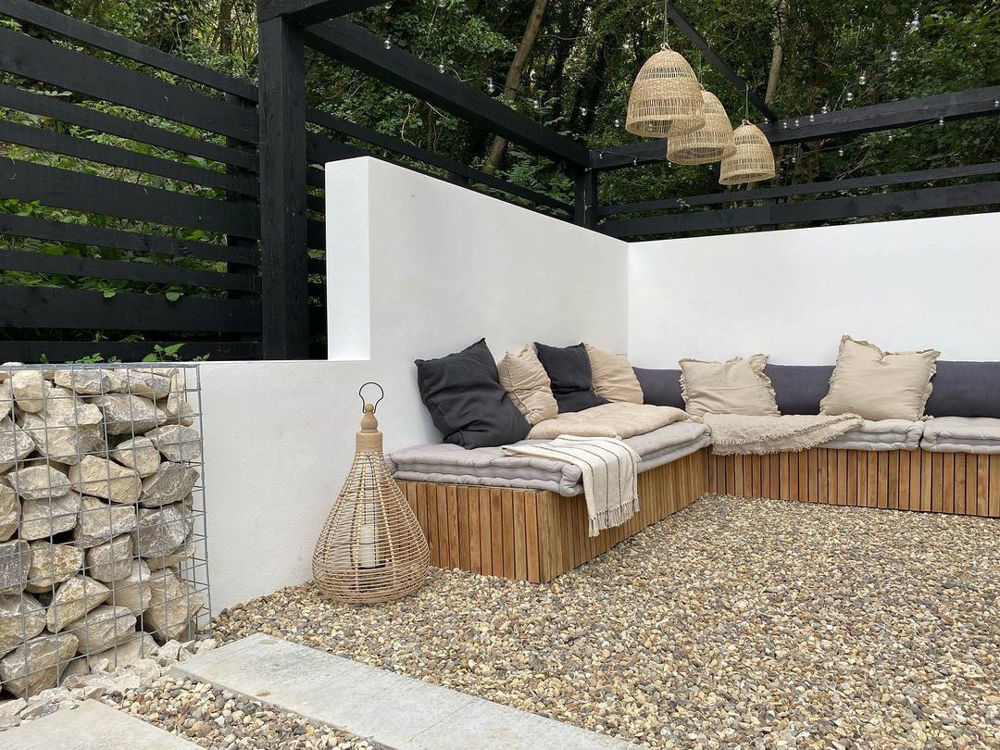
Frequently Asked Questions
Q. DOES THE PAINT HAVE TO BE COMPATIBLE WITH THE RENDER?
Absolutely, this is a crucial part of painting render that you must consider. If a paint is not compatible with a render, it will simply fail after a matter of months. The type of render that you must be careful with when painting it is silicone render. This is because it has water repellent properties that will simply repel paint when applied to it, if you do not use a silicone-based masonry paint. The silicone in the paint means that you can paint a silicone render with silicone masonry paint without it repelling the coating as it contains the same formulation. Emperor Masonry Paint can be applied to any exterior walled surface, including previously painted renders that have been painted with acrylic masonry paint, so you do not have to worry about whether your render is compatible with the coating.
Q. DOES RENDER HAVE TO BE DRY TO PAINT?
Yes, you must ensure render is completely dry before painting. This is the case whether it is new render, or old render that has been exposed to rainfall recently. Generally, you must wait at least 2 weeks once new render is applied to be able to paint it. Similarly, you must wait for render to be dry before painting it, so ensure you have given it a couple of days of clear weather to dry out before you paint.
Q. HOW MUCH WATERPROOFING PAINT WILL I NEED?
Emperor Masonry Paint has a coverage of 5-6m2 per litre & Emperor Masonry Creme has a coverage of 3-5m2 per litre. With the paint being a two-coat system, this means you will need 10L of paint to cover 30m2, while the one-coat masonry cream will require roughly 10L to cover up to 50m2. The coverage of the treatments depends on the texture of the surface you are painting. If you are painting a rougher render like pebbledash, your coverage will be reduced to 3m2 per litre as you have a larger amount of surface to cover.
We hope we have answered any questions you may have had regarding waterproofing render. Why not order your sample pot of Emperor Masonry Paint or Emperor Masonry Creme and see the super hydrophobic technology for yourself? Alternatively, if you have a question regarding treating your render, get in touch with our experts by emailing [email protected].

